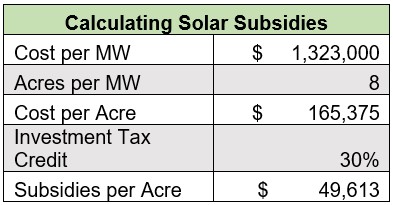Solar subsidies amount to $50,000 per acre
Did you know that solar facilities are subsidized to the tune of almost $50,000 per acre? Here is how the math works.
According to the U.S. Energy Information Administration, a new solar facility in Minnesota costs around $1.3 million per megawatt (MW) of installed capacity. Each MW of solar consumes approximately 8 acres of land, and the subsidy is 30 percent.
The result? Subsidies reaching nearly $50,000 per acre.

Given these enormous amounts of taxpayer cash being lavished on solar developers, it comes as no surprise that in some areas, electric companies are offering farmers anywhere from $800 to $1,400 per acre to put solar panels on the fields, which is much more than they could ever hope to earn on the fields farming.
In Sherburne County, Minnesota, Xcel Energy is proposing to build a 460 MW solar facility, which will consume nearly 3,700 acres of farmland and $182.6 million in your tax dollars.
For this privilege, Xcel Energy customers will also see their electricity prices rise, and unreliable solar panels fail to make up for the reliable, affordable electricity generated at the Shercburn County coal plant, which Xcel wants to shut down as soon as possible.
Companies would not be building solar if not for the lavish taxpayer subsidies and the ability for government-approved utilities to simply raise the cost of power on the ratepayers to finance them. This means our federal and state governments are essentially forcing the rest of us to finance the removal of productive farmland from production in exchange for solar panels that produce only 18 percent of their potential output.
This is why the ‘Future Agriculture Retention and Management Act,” or FARM act, proposed by Wisconsin congressman Tom Tiffany (WI-7), which would eliminate energy tax incentives that help finance green energy sources such as solar panels or wind arrays if such projects result in the loss of farmland, is a good idea.
The FARM Act wouldn’t get rid of subsidies altogether. It would simply remove the generous $50,000 per acre subsidies that are being used to take our Midwestern farmland out of the business of producing the food we put on our tables.